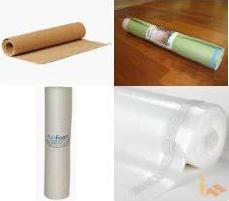Just a few years ago the choice of underlayment for use with laminate flooring was a simple question with a simple answer. However, manufacturers and their technologies do not stand still. Newly created underlayment have benefits which previously were not available, making the choice of the proper laminate underlayment, for your situation, a much more complex decision, as shown in Figure 1.

Figure 1 - Four of the many types of underlayment available
Always verify the manufacturers warranty, to ensure that the underlayment you are planning on using will not void it.
The following information should provide you with the knowledge necessary to make an informed decision and choose the laminate or engineered hardwood flooring underlayment that is best for your project.
The Use Of Underlayment:
Laminate flooring and engineered hardwood flooring sit on top of the sub-floor. At no time are they meant to be glued or nailed to the sub-floor and because of this they are termed "floating" floors. Each piece of flooring material, laminate or engineered hardwood attaches to the previous piece, generally using a tongue and grove technique. In some instances the tongues and grooves have an adhesive applied to them to complete the joint, in other cases they lock together using a tongue that is specially shaped to fit into an oppositely shaped groove. In either case, glue or locking tongue and groove, the material is installed and fitted together on top of an underlayment which rests on the sub-floor.
The underlayment provides 3 functions:
- It levels minor inconsistencies in the surface of the sub-floor.
- It acts as a sound attenuator, helping to reduce the transmission of sound between floors.
- It provides a feeling of additional comfort when traversing the floor.
Underlayment for laminate or engineered hardwood flooring is not designed to provide the same overall functions as carpet under padding. Where the thickness of carpet under padding creates a plusher feel when walking on it. Installing a thicker underlayment with laminate or engineered hardwood flooring will not make the flooring feel any more comfortable to walk on. It will, however, increase the attenuation of noise between floors and increase the amount of sub-floor inconsistencies that can be endured.
There are 5 basic types of underlayment that can be used between the sub-floor and either laminate or engineered hardwood flooring:
- Cork
- Standard Foam
- Standard Foam, Moisture Barrier Combination
- Modified, Upgraded
- Floor Muffler™
It is extremely important that you use the underlayment recommended by the manufacture of the laminate or engineered hardwood flooring. The use of the wrong underlayment can cause joints to open, reduce the life of the flooring and void warrantees.

Figure 2 - Standard foam underlayment
Standard Foam or Base Grade Underlayment:
Of all the underlayment available the standard foam or base grade underlayment (Figure 2) is used more than any other. Standard foam underlayment is sold under a variety of trade names, but for all intent purposes it is the same basic product - a 1/8 inch thick foam padding. Depending on the specific manufacture standard foam is generally sold in rolls that cover 100 sq. ft., although some manufactures offer much larger rolls for commercial applications and use by professional installers.
Even though it is the most commonly used underlayment it provides very poor sound attenuation, a negligible increase in comfort and does little to correct any imperfections in the sub-floor.
